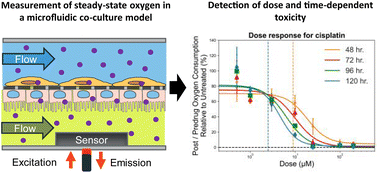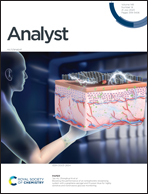Steady-state monitoring of oxygen in a high-throughput organ-on-chip platform enables rapid and non-invasive assessment of drug-induced nephrotoxicity†
Abstract
High-throughput, rapid and non-invasive readouts of tissue health in microfluidic kidney co-culture models would expand their capabilities for pre-clinical assessment of drug-induced nephrotoxicity. Here, we demonstrate a technique for monitoring steady state oxygen levels in PREDICT96-O2, a high-throughput organ-on-chip platform with integrated optical-based oxygen sensors, for evaluation of drug-induced nephrotoxicity in a human microfluidic co-culture model of the kidney proximal tubule (PT). Oxygen consumption measurements in PREDICT96-O2 detected dose and time-dependent injury responses of human PT cells to cisplatin, a drug with known toxic effects in the PT. The injury concentration threshold of cisplatin decreased exponentially from 19.8 μM after 1 day to 2.3 μM following a clinically relevant exposure duration of 5 days. Additionally, oxygen consumption measurements resulted in a more robust and expected dose-dependent injury response over multiple days of cisplatin exposure compared to colorimetric-based cytotoxicity readouts. The results of this study demonstrate the utility of steady state oxygen measurements as a rapid, non-invasive, and kinetic readout of drug-induced injury in high-throughput microfluidic kidney co-culture models.

- This article is part of the themed collections: 150th Anniversary Collection: Sensors for Human and Planetary Health and Analyst HOT Articles 2023


 Please wait while we load your content...
Please wait while we load your content...